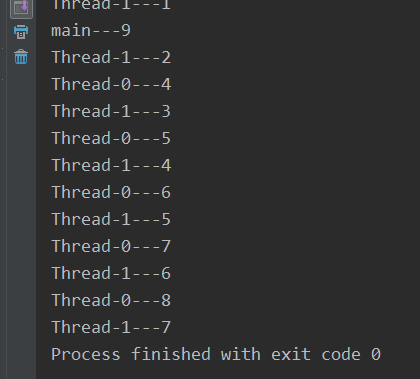创建线程
方式一:继承Thread
- 自定义一个类继承Thread类
- 重写Thread的run方法,把自定义线程的任务代码定义在run方法上
- 创建Thread子类的对象,并且调用start方法启动一个线程
public class MyThread extends Thread {
public void run() {
for (int i = 0; i < 100; i++)
System.out.println(getName() + i);
}
}
// test
MyThread my1=new MyThread();//设置线程名
MyThread my2=new MyThread();
my1.setName("线程1 ");
my2.setName("线程2 ");
my1.start();
my2.start();

方式二: 实现Runnable接口。
Thread类使用静态代理实现,Thread构造函数接收一个实现Runnable接口的类作为代理类
Thread类本身继承自Runnable接口
- 自定义一个类实现Runnable接口。
- 实现Runnable接口中的run方法,把自定义线程的任务代码定义在run方法上
- 创建Runable实现类 的对象
- 创建Thread对象,并且把Runnable实现类的对象作为参数传递
- 调用Thread对象的start方法开启线程。
public class DeamonDemo implements Runnable{
@Override
public void run() {
for(int i = 0;i<100;i++)
System.out.println(Thread.currentThread().getName()+"---"+i);
}
}
// test
public class DeamonTest {
public static void main(String[] args) {
DeamonDemo d = new DeamonDemo();
Thread d1 = new Thread(d);
Thread d2 = new Thread(d);
d1.start();
d2.start();
}
}
方式三:实现Callable接口
Callable是线程池的方式创建线程,可以获取到执行函数的返回值,还可以在执行时抛出异常
- 实现Callable接口,Callable是一个泛型接口,指定call函数返回值类型
- 实例化实现了Callable接口类
- 创建线程池Executors.newFixedThreadPool(3),指定线程池大小
- 提交执行,executor.submit(testCallable1),传递实现了Callable接口类
- 获取执行结果,executor.submit提交后可获取执行结果
- 关闭线程池,executorService.shutdown();
public class TestCallable<T> implements Callable<T> {
@Override
public T call() throws Exception {
for (int cnt = 0; cnt < 100;cnt++) {
System.out.println(Thread.currentThread().getName()+" :cnt = " + cnt);
}
return null;
}
public static void main(String[] args) throws ExecutionException, InterruptedException {
for (int cnt = 0; cnt < 100;cnt++) {
System.out.println(Thread.currentThread().getName()+" :cnt = " + cnt);
}
// 创建线程类
TestCallable<Object> testCallable1 = new TestCallable<>();
// 创建线程池,初始化线程池大小
ExecutorService executorService = Executors.newFixedThreadPool(3);
// 提交执行
Future<Object> future = executorService.submit(testCallable1);
// 获取执行结果
Object result = future.get();
// 服务关闭
executorService.shutdown();
}
}
守护线程
线程分为用户线程和守护线程,JVM中只有当所有用户线程结束,守护线程才会结束,守护线程的作用就是为其他线程提供服务,GC就是一个守护线程
用户线程 :是高优先级线程。JVM 会在终止之前等待任何用户线程完成其任务。
守护线程 :是低优先级线程。其唯一作用是为用户线程提供服务。
- 设置守护线程,一旦主线程结束就结束守护线程
- 主线程是用户线程
- 守护线程中产生的线程也是守护线程
DeamonDemo d = new DeamonDemo();
Thread d1 = new Thread(d);
Thread d2 = new Thread(d);
d1.setDaemon(true); // 设置守护线程
d2.setDaemon(true);
d1.start();
d2.start();
for(int i = 0;i<10;i++){
//打印main线程(主线程)线程名
System.out.println(Thread.currentThread().getName()+"---"+i);
}

设置线程优先级
- IllegalArgumentException
- void setPriority()
- int getPriority():优先级范围1-10 默认5
PriorityDemo p = new PriorityDemo();
Thread tp1 = new Thread(p);
Thread tp2 = new Thread(p);
Thread tp3 = new Thread(p);
tp1.setName("xyg");
tp2.setName("wdf");
tp3.setName("OoO");
tp1.setPriority(10); // 最高优先级
tp2.setPriority(1);
tp3.setPriority(1);
tp1.start();
tp2.start();
tp3.start();

线程状态
- 线程通过thread.getState()方法获取状态
线程的六种状态
- NEW:未启动状态
- RUNNABLE:执行中
- BLOCKED:等待线程锁
- WAITING:线程等待
- TIMED_WAITING:线程睡眠
- TERMINATED:完成执行
public static void main(String[] args) {
Thread thread = new Thread(() -> {
for (int i = 0; i < 10; i++) {
try {
Thread.sleep(1);
} catch (InterruptedException e) {
e.printStackTrace();
}
}
});
thread.start();
while (true) {
if (thread.getState() == Thread.State.TERMINATED) {
break;
}
System.out.println("thread = " + thread.getState());
}
}
...
thread = TIMED_WAITING
thread = TIMED_WAITING
thread = RUNNABLE
thread = RUNNABLE
thread = TERMINATED
线程加入 join
- 一旦有join()线程,其他线程必须等待
JoinDemo p = new JoinDemo();
Thread tp1 = new Thread(p);
Thread tp2 = new Thread(p);
Thread tp3 = new Thread(p);
tp1.setName("xyg");
tp2.setName("fuck");
tp3.setName("wdnmd");
tp1.setPriority(10);
tp2.setPriority(1);
tp3.setPriority(1);
tp1.start();
try {
tp1.join(); // 其他线程等待该线程终止
} catch (InterruptedException e) {
e.printStackTrace();
}
tp2.start();
tp3.start();

线程暂停
- public static void yield()----Thread:暂停当前正在执行的线程,并执行其他线程
- 使用yield()的目的是让相同优先级的线程之间能适当的轮转执行。但是,实际中无法保证yield()达到让步目的
- 因为让步的线程还有可能被线程调度程序再次选中。
public void run() {
for(int i = 0;i<100;i++){
System.out.println(Thread.currentThread().getName()+"---"+i);
Thread.yield(); //执行其他线程
}
}
线程安全
多个线程操作同一个数据,解决:添加锁
同步代码块
- 同步代码块的锁可以是任意的对象。 同步函数的锁是固定 的,非静态函数的锁对象是this对象。 静态函数的锁对象是class对象。
- 锁对象必须是多线程共享的对象,否则锁不住
- 在同步代码块或者是同步函数中调用sleep方法是不会释放锁对象的,如果是调用了wait方法是会释放锁对象的。
...
public void run() {
if (x%2==0) {
//同步代码块
synchronized (this) {// 多个线程使用同一个锁对象
if (ticket > 0) {
try {
Thread.sleep(100);
} catch (InterruptedException e) {
e.printStackTrace();
}
System.out.println(Thread.currentThread().getName() + "正在出售第" + (ticket--) + "张票。");
}
}
}
方法锁
- 同步代码块的锁可以是任意的对象。 同步函数的锁是固定 的,非静态函数的锁对象是this对象。 静态函数的锁对象是class对象。
public void run() {
check();
}
...
//同步方法
//同步方法的锁对象是this对象
//静态同步方法的锁对象是 类名.class Class类型对象
private synchronized void check() {
if (ticket > 0) {
try {
Thread.sleep(100);
} catch (InterruptedException e) {
e.printStackTrace();
}
System.out.println(Thread.currentThread().getName() + "正在出售第" + (ticket--) + "张票。");
}
}
Arraylist线程安全
- 使用了同步代码块锁住了arraylist的添加
- sleep为了解决主线程过早结束
public static void main(String[] args) {
ArrayList<Object> objects = new ArrayList<>();
for (int i = 0; i < 1000; i++) {
Thread thread = new Thread(() -> {
synchronized (objects){
objects.add(Thread.currentThread().getName());
}
});
thread.start();
}
try {
Thread.sleep(3000);
} catch (InterruptedException e) {
e.printStackTrace();
}
System.out.println("objects = " + objects.size());
}
Juc的线程安全集合
public class JucList {
public static void main(String[] args) {
CopyOnWriteArrayList<Object> objects = new CopyOnWriteArrayList<>();
for (int i = 0; i < 1000; i++) {
Thread thread = new Thread(() -> {
objects.add(Thread.currentThread().getName());
});
thread.start();
}
try {
Thread.sleep(3000);
} catch (InterruptedException e) {
e.printStackTrace();
}
System.out.println("objects = " + objects.size());
}
}
ReentrantLock
- ReentrantLock()默认构造非公平锁,构造函数传递true实例化为公平锁
公平锁是指多个线程同时尝试获取同一把锁时,获取锁的顺序按照线程达到的顺序, 非公平锁则允许线程“插队”
- ReentrantLock.lock():加锁
- ReentrantLock.unLock():解锁
public class ReentrantLockTest {
public static void main(String[] args) throws InterruptedException {
Ticket t1 = new Ticket();
Thread thread1 = new Thread(t1);
Thread thread2 = new Thread(t1);
thread1.start();
thread2.start();
}
}
class Ticket implements Runnable {
Integer ticket = 100;
/**
* 公平锁是指多个线程同时尝试获取同一把锁时,获取锁的顺序按照线程达到的顺序
* 非公平锁则允许线程“插队”
*/
private Lock reenlock = new ReentrantLock(); //初始为非公平锁
//private Lock reenlock = new ReentrantLock(true); // 初始化为公平锁
@Override
public void run() {
while (true) {
// 锁机制
reenlock.lock();
try {
if (ticket > 0) {
try {
Thread.sleep(100);
} catch (InterruptedException e) {
e.printStackTrace();
}
System.out.println(Thread.currentThread().getName() + "正在出售第" + (ticket--) + "张票。");
} else {
break;
}
} finally {
// 解锁
reenlock.unlock();
}
}
}
}
synchronized 和 ReentrantLock
- 可重入锁是指同一个线程可以多次获取同一把锁,synchronized 和 ReentrantLock都是可重入锁
- 是否可以响应中断,synchronized 过程中不可响应中断,ReentrantLock提供了中断功能
- synchronized是非公平锁,ReentrantLock可通过构造方法指定公平锁和非公平锁,默认构造为非公平锁
死锁
线程死锁是指两个或两个以上的线程互相持有对方所需要的资源,由于synchronized的特性,一个线程持有一个资源,或者说获得一个锁,在该线程释放这个锁之前,其它线程是获取不到这个锁的,而且会一直死等下去,因此这便造成了死锁
public class DeadLock {
private Object lock1 = new Object();
private Object lock2 = new Object();
public void thread1Method() {
synchronized (lock1) {
System.out.println(Thread.currentThread().getName()+":获取到lock1,请求lock2");
try {
Thread.sleep(1000);
} catch (InterruptedException e) {
e.printStackTrace();
}
synchronized (lock2) {
System.out.println(Thread.currentThread().getName()+":获取到lock2");
}
}
}
public void thread2Method() {
synchronized (lock2) {
System.out.println(Thread.currentThread().getName()+":获取到lock2,请求lock1");
try {
Thread.sleep(1000);
} catch (InterruptedException e) {
e.printStackTrace();
}
synchronized (lock1) {
System.out.println(Thread.currentThread().getName()+":获取到lock1");
}
}
}
public static void main(String[] args) {
DeadLock deadLock = new DeadLock();
new Thread(()->{
deadLock.thread1Method();
}).start();
new Thread(()->{
deadLock.thread2Method();
}).start();
}
}
线程通信
- wait() 让当前线程释放对象锁并进入等待(阻塞)状态
- notify() :唤醒一个正在等待相应对象锁的线程,使其进入就绪队列
- notifyAll():唤醒所有正在等待相应对象锁的线程,使它们进入就绪队列
wait()和sleep()
- wait()是Object类方法,释放锁对象
- sleep()是Thread类的的静态方法,不释放锁对象
public synchronized void set(String name, int age) {
//如果有数据则等待
if (flag) {
try {
wait(); // 线程等待
} catch (InterruptedException e) {
e.printStackTrace();
}
}
//设置值
this.name=name;
this.age=age;
// 修改标记
flag = true;
notify();// 线程唤醒
}
...
public synchronized void get(){
//如果没有数据就等待
if(!flag){
try {
wait(); // 线程等待
} catch (InterruptedException e) {
e.printStackTrace();
}
}
System.out.println(name+" "+age);
//修改标记
flag=false;
notify(); // 线程唤醒
}
生产者消费者问题
/**
* 生产者消费者问题
* 生产者不停生产,消费者不停消费。。
1 products ware produced.
1 product ware Consumed.
2 products ware produced.
3 products ware produced.
4 products ware produced.
2 product ware Consumed.
5 products ware produced.
3 product ware Consumed.
6 products ware produced.
4 product ware Consumed.
7 products ware produced.
5 product ware Consumed.
...
*/
public class ProducersAndConsumers {
public static void main(String[] args) {
Depostory depostory = new Depostory();
Producers producers = new Producers(depostory);
Consumers consumers = new Consumers(depostory);
new Thread(producers).start();
new Thread(consumers).start();
}
}
// 产品
class Product{
int id;
public Product(int id) {
this.id = id;
}
}
// 生产者
class Producers implements Runnable{
Depostory depostory;
public Producers(Depostory depostory) {
this.depostory = depostory;
}
@Override
public void run() {
for (int i = 1; ; i++) {
depostory.push(new Product(i));
System.out.println(i+" products"+" ware produced.");
}
}
}
// 消费者
class Consumers implements Runnable{
Depostory depostory;
public Consumers(Depostory depostory) {
this.depostory = depostory;
}
@Override
public void run() {
while (true){
Product pop = depostory.pop();
System.out.println(pop.id+" product "+ "ware Consumed.");
}
}
}
// 仓库
class Depostory{
List<Product> products = new ArrayList<>();
private int size = 5; // 仓库容量
// 生产者生产产品
public synchronized void push(Product product){
if (size == products.size()) {
// 等待消费者消费
try {
wait();
} catch (InterruptedException e) {
e.printStackTrace();
}
}
try {
Thread.sleep(10);
} catch (InterruptedException e) {
e.printStackTrace();
}
products.add(product);
notifyAll(); //通知消费者消费
}
// 消费者消费产品
public synchronized Product pop(){
if (products.size() == 0) {
try {
wait(); // 线程等待,等待生产者生产
} catch (InterruptedException e) {
e.printStackTrace();
}
}
try {
Thread.sleep(1000);
} catch (InterruptedException e) {
e.printStackTrace();
}
Product product = products.get(0);
products.remove(product);
notifyAll(); // 线程唤醒,通知
return product;
}
}
通过事件通知线程
/**
* 线程2等待线程2运行n秒后再运行,使用标记事件的方式
*/
public class ThreadEventDemo {
public static void main(String[] args) {
Event event = new Event();
Thread1 thread1 = new Thread1(event);
Thread2 thread2 = new Thread2(event);
new Thread(thread1).start();
new Thread(thread2).start();
}
}
// Thread1
class Thread1 implements Runnable {
Event evnet;
int cnt = 0;
public Thread1(Event evnet) {
this.evnet = evnet;
}
@Override
public void run() {
while (true) {
try {
Thread.sleep(1000);
} catch (InterruptedException e) {
e.printStackTrace();
}
cnt++;
if (cnt == 2) {
evnet.flag = true; // 设置事件
}
System.out.println("thread1 run for " + cnt + "seconds.");
}
}
}
// Thread2
class Thread2 implements Runnable {
Event evnet;
public Thread2(Event evnet) {
this.evnet = evnet;
}
@Override
public void run() {
while (true) {
// 等待事件激活
if (evnet.flag) {
System.out.println("thread2 running..");
}
try {
Thread.sleep(1000);
} catch (InterruptedException e) {
e.printStackTrace();
}
}
}
}
// Event
class Event {
boolean flag = false; // 事件默认未激活
}
管道通信
- PipedOutputStream:可以向管道中写入数据,
- PipedIntputStream:可以读取PipedOutputStream向管道中写入的数据,这两个类主要用来完成线程之间的通信
PipedInputStream中,有一个buffer字节数组,默认大小为1024,作为缓冲区
- 构造PipedInputStream、PipedOutputStream
- 使用connect方法连接对方
- PipedOutputStream.write(bytes)方法向通道写入字节数组
- length = PipedIntputStream.read(bytes)方法向通道读取数组,当返回length为-1时读取完全部
/**
* 线程间,管道通信
*/
public class PipedDemo {
public static void main(String[] args) throws IOException, InterruptedException {
PipedInputStream pipedInputStream = new PipedInputStream();
PipedOutputStream pipedOutputStream = new PipedOutputStream();
//pipedInputStream.connect(pipedOutputStream); // 效果相同
pipedOutputStream.connect(pipedInputStream);
new Thread(new WriteThread(pipedOutputStream)).start();
Thread.sleep(1000);
new Thread(new ReadThread(pipedInputStream)).start();
}
}
// 写线程
class WriteThread implements Runnable {
PipedOutputStream pipedOutputStream;
public WriteThread(PipedOutputStream pipedOutputStream) {
this.pipedOutputStream = pipedOutputStream;
}
@Override
public void run() {
System.out.println("write:");
try {
for (int i = 0; i < 30; i++) {
System.out.print(i);
byte[] bytes = Integer.toString(i).getBytes();
pipedOutputStream.write(bytes);
}
pipedOutputStream.close();
System.out.println();
} catch (IOException e) {
e.printStackTrace();
}
}
}
// 读线程
class ReadThread implements Runnable {
PipedInputStream pipedInputStream;
public ReadThread(PipedInputStream pipedInputStream) {
this.pipedInputStream = pipedInputStream;
}
@Override
public void run() {
byte[] bytes = new byte[20];
try {
int length = pipedInputStream.read(bytes);
System.out.println("read:");
// -1 表示读取完了
while (-1 != length) {
String s = new String(bytes, 0, length);
System.out.print(s);
length = pipedInputStream.read(bytes);
}
pipedInputStream.close();
} catch (IOException e) {
e.printStackTrace();
}
}
}
/**
* output:
*
write:
01234567891011121314151617181920212223242526272829
read:
01234567891011121314151617181920212223242526272829
*
*/